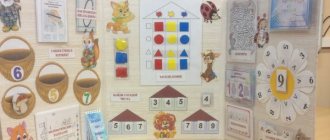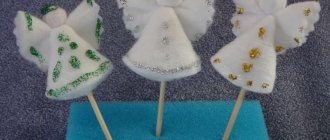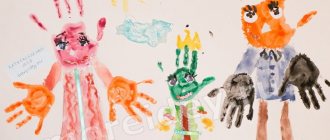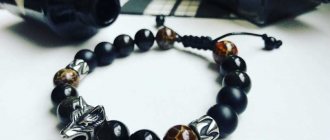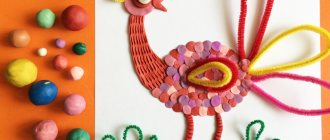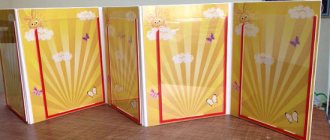Master class “Using photo-case technology in working with preschoolers”
Self-presentation
Dear colleagues! My name is Nikolenko Elina Aleksandrovna. I represent the child development center kindergarten No. 13.
There were no teachers in my family, but since childhood I had respect for the teachers at my school, I really wanted to become one of them. After graduating from school, I entered the Rossoshansky Pedagogical College, and then the Borisoglebsky Pedagogical Institute. Fate brought me to kindergarten, where I have been working for almost seven years.
The most important thing for a teacher is to love children, to love just like that, to give them your heart. I love my job, my kids, my kindergarten.
My pedagogical credo is “Create, try, search and develop!”
As a teacher, I am constantly in search of new methods, techniques, knowledge, how to properly and intelligently organize the activities of students, how to make it interesting and educational for children. For some time now photography has become my hobby. I like to see the world through different eyes, and the camera viewfinder allows me to do this, capture it and share it with my children. When you have a camera in your hands, you inevitably start looking for interesting moments.
My students really enjoyed looking at the photographs, and I decided to use photographic equipment in my work.
Photographs perform special practical tasks. They are created by me for:
- to study new material;
- to consolidate what has been learned;
- for repetition, practical application of acquired knowledge;
- for generalization and systematization of knowledge.
Photography can be successfully used in solving problems with adaptation in kindergarten. Using photographs, it is very good to conduct conversations on various topics, compose descriptive stories, teach how to ask questions, consider the seasons, etc.
Within the framework of this topic, I organized photo exhibitions, photographic observations, designed photo albums, created photo collages, presentations, didactic, role-playing games, a traffic light of emotions (in the mood corner), photo books, photo cases, etc.
Master Class
Within the framework of the Federal State Educational Standard, among a number of tasks, the teacher faced, one might say, the main task: “raising a child of the 21st century,” i.e. a “thinking” child, capable of thinking analytically. In a word, the educator needs to move from transferring ready-made knowledge to motivating students to show initiative and independence in resolving issues that arise. In this regard, in my work I began to use “Photo-case” technology
.
"Photo case - technology"
is an interactive technology for short-term training based on real or near-reality situations, aimed mainly at developing new qualities and skills.
The purpose of the work
it involves analyzing the essence of the problem, analyzing possible solutions and choosing the best one.
The “photo case” includes:
- A photo whose subject reflects a problem.
Photo “Alenka lost her doll”
Any photo case is created for a specific purpose. The purpose of this photo case is:
Target:
learn to determine and denote in words the position of an object relative to oneself: above, below, in the middle, on the right, on the left, on, under, in, etc.
- Text for a case that describes a set of events.
Text.
Today Alenka came to kindergarten with a doll. Coming from a walk, she didn’t find her favorite toy and burst into tears.
In the preparatory group, the teacher invites children to formulate the problem themselves, based on this photograph, without attaching text to the photo case.
- A task is a correctly posed question. It must be motivated to solve the problem.
Question.
What would you do if you were Alenka?
The situation we choose must meet the needs of preschoolers and illustrate the problems that a child may encounter in life or has already encountered. Specific examples are better retained in children's memory. A specific situation combines knowledge and practice and requires the child to actively participate mentally and emotionally in analysis and discussion.
Naturally, this situation should “hook” the child. It should contain enough information, should be within the students' ability, and should not contain hints regarding how to solve the problem.
Practical activities with preschoolers are built within the framework of a technological map, which is adapted to the technology and reflects the specifics of the “photo case”, which defines the sequential stages of the activities of the teacher and children. This work can be carried out in subgroups, each of which must make one general decision, be able to justify and prove its correctness.
And now that we have briefly examined the theoretical aspect, I propose to look at several examples of “photo case technology”. Each focus group will receive a “photo case”, which is intended for a specific age group of preschoolers. Let's start with the second youngest group. (In younger groups, you can create “photo cases” mainly for mastering cultural and hygienic skills)
2nd junior group
Photo “Washing”
Target:
cultivate the habit of washing yourself, washing your hands with soap before eating.
Text:
Sasha came to kindergarten for the first day.
Before breakfast, the children went to wash their hands. And Sasha stood, waiting for the teacher, and did not know what to do. What would you do if you were Sasha?
Middle group
This “photo case” can be used in GCD.
Photo “Visiting the bear cub”
Target:
consolidate knowledge about length.
Text:
The little bear invited his friends - his neighbors: a little hare, a little squirrel, a little wolf.
The guys were so happy that they decided to have a competition to see who could run from their house to the bear cub’s house the fastest. The hare came first, the little squirrel came second, and the wolf came last. Why did the wolf run for so long?
Photo cases can contain one photo (like the previous two), or there can be photo cases with a continuation (contain several photos).
Senior group
Photo "Doll"
Target:
teach children to analyze actions; promote the development of moral aspects of behavior.
Text:
During the game, Nastya allowed her friend Olya to play with her favorite doll.
Olya promised to play and return the doll back. But she accidentally broke it. Olya was afraid to tell Nastya about this. What would you do if you were Ole?
Preparatory group
Photo “How to cross the street correctly”
Target
: reinforce the rules of the road.
And using the example of children from the preparatory group, the fourth focus group under my leadership will try to find a way out of the current situation. We will try to go through all the stages of “photo case technology”.
Technological map for working with case photos “How to cross the street correctly”
| Stages | Activities of the teacher | Children's activities |
| The teacher invites the children to look at the photo. | Children look at the photo. Accept the situation. |
| — What is the girl doing in the photo? (offers to formulate the problem) — What didn’t the girl take into account when crossing the road in this place? - What could be the consequences of this action? | — The girl breaks traffic rules. Crosses the road in the wrong place. — The girl could get hit by a car. |
| — Think about how to find a way out of this situation? | They think. — Cross the road only in a designated place at a pedestrian crossing and only when the traffic light is green. — Cross the road with older brothers or sisters, holding hands, at a pedestrian crossing, at a green traffic light. — Cross the road only with your parents, holding hands tightly, and only at a pedestrian crossing. — If there are no parents nearby, ask the traffic police inspector for help. |
| — You have offered many answers. Let's choose someone's one, the one that seems most correct in your opinion. | Children choose one answer. |
| — Guys, voice your answer on how the girl can cross the road safely. — Why did you choose this option? | Children voice the most correct answer, in their opinion. |
| — Children, what would you do if you found yourself in such a situation? — In order to avoid getting into such situations, what do you need to know? | Children name options for their behavior patterns in a similar situation. Children's answers. |
Using the same scheme, the teacher builds work with other age groups of children.
Conclusion: “Photo case
-technology” helps to increase children’s interest in the material being studied, develops in them such qualities as social activity, communication skills, the ability to listen and competently express their thoughts.
The main purpose of the “photo case”
-technology" - develop the ability to explore various problems and find solutions to them, that is, learn to work with information.
Math house
Didactic manual on mathematics for children of middle and senior preschool age.
The game exercises proposed in the manual will help preschoolers from 4 to 7 years old to better remember numbers and geometric shapes, and to correctly use the mathematical sign “more-less.” Games with the teaching aid “Math House” attract preschoolers with the variety of rules, easy change of the playing field, and the opportunity to play independently or with peers.
I present to the readers several game tasks that are designed for children of senior preschool age.
Postman
Equipment
: mailboxes - they are made of empty matchboxes with numbers from 1 to 9; a set of letter cards made of white cardboard 3 x 2 cm with numbers from 1 to 50.
Objectives and descriptions of games
Option 1
- consolidate knowledge of numbers from 1 to 9, skills of visual correlation between them on the letter itself and on the mailbox.
Description
: the child is asked to put letters with the numbers of the first ten into the appropriate mailboxes.
Option 2
- highlight numbers from 1 to 9 among others, name them and correlate them with the numbers on mailboxes; intensify the search for solutions to the given game problem.
Description
: The child is asked to choose among 15 cards only letters with the numbers indicated on the mailboxes and arrange them correctly.
cat house
Equipment
: windows on the wall of the house in the form of a square, circle, semicircle, triangle, rectangle, pentagon, oval, hexagon, on which kittens sit; curtains corresponding to the windows made of thick colored paper.
Tasks
: consolidate the names of geometric shapes, skills of visual and tactile correlation of the shape of the “curtain” with the shape of the “window”.
Description
: The child is asked to hide the kittens by choosing appropriately shaped curtains for the windows, and correctly name the geometric shapes.
Big small
Equipment
: paired pictures with images of large and small sizes, cards with arrows, more-less signs.
Tasks
: consolidate the concepts of “more”, “less”, “left”, “right”, “between”; the ability to correctly indicate relationships between objects using arrows and signs.
Description
. The child is asked to attach arrows on the wall of the house between pairs of pictures or pictures near the arrow so that the “nose” of the arrows points towards the smaller picture. After the child remembers the direction of the arrow, the teacher says: “Look, the stick has run away from the arrow, only the nose remains!” and shows the mathematical sign “more or less.” Children usually show interest and easily learn the rules for using the sign.
Multicolored square
Equipment
: a square wall of the house, which consists of basic geometric shapes of different colors and sizes; dice.
Task
: teach a child to find given figures on a noisy background.
Description
.
Option 1
- the child is asked to name a geometric figure, throw the dice and find on the playing field as many of the same figures as the number of dots on the dice.
Option 2
- find pieces on the playing field whose number of corners matches the number of dots rolled on the die.
Alena Nadeeva, teacher
at MBDOU D/s No. 30, city district Samara
